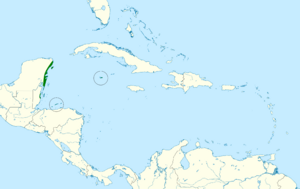Yucatan vireo facts for kids
Quick facts for kids Yucatan vireo |
|
|---|---|
 |
|
| Conservation status | |
| Scientific classification | |
| Genus: |
Vireo
|
| Species: |
magister
|
 |
|
The Yucatan vireo (Vireo magister) is a small songbird. It belongs to a bird family called Vireonidae. These birds are known for their strong, hooked beaks.
It is a close relative of the red-eyed vireo. However, the Yucatan vireo has feathers that are not as bright.
What Does It Look Like?
This bird is about 14.5 to 15.5 centimeters (around 6 inches) long. It has a strong, hooked beak that is gray. The bottom part of its beak is a lighter gray.
You can spot a wide white stripe above its eye. This stripe stands out against its dull gray head. A dark stripe goes through its brown eye. The top of its body is a dull olive-gray color. Its throat and belly are whitish. Its wings and tail are dark, with olive-green edges. The legs and feet of the Yucatan vireo are grayish-blue.
Where Does It Live?
The Yucatan vireo lives in different types of forests. Its natural habitats include dry forests in warm areas. It also lives in mangrove forests, which are found near coastlines. Sometimes, it can be found in areas where forests have been cut down.
Where Can You Find It?
This bird is found in several countries. You can see it in Belize, Honduras, and Mexico. It also lives on the island of Grand Cayman.
There is only one known record of this bird in the United States. It was seen in High Island, Texas, in 1984.
Types of Yucatan Vireos
Scientists recognize four different types, or subspecies, of the Yucatan vireo. These different types exist because the birds live on islands and a small part of the mainland.
- Vireo magister magister – This is the main type. It lives in southeastern Mexico and Belize.
- Vireo magister decoloratus – This type is found on islands near northern and central Belize.
- Vireo magister stilesi – You can find this type on islands off southern Belize and northern Honduras.
- Vireo magister caymanensis – This type lives on Grand Cayman Island.


